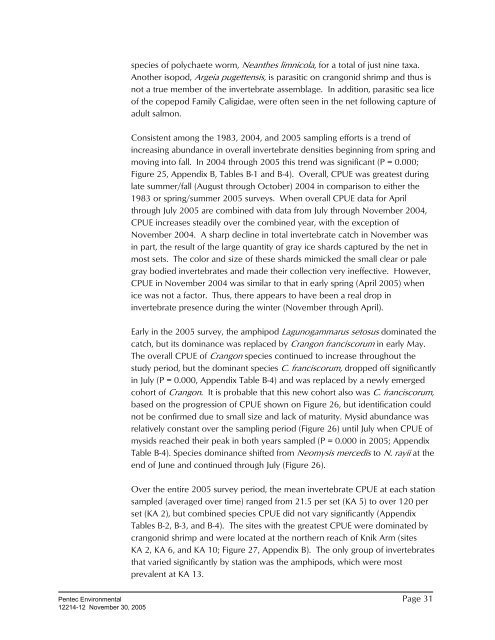Marine Fish and Benthos Studies - Knik Arm Bridge and Toll Authority
Marine Fish and Benthos Studies - Knik Arm Bridge and Toll Authority
Marine Fish and Benthos Studies - Knik Arm Bridge and Toll Authority
You also want an ePaper? Increase the reach of your titles
YUMPU automatically turns print PDFs into web optimized ePapers that Google loves.
species of polychaete worm, Neanthes limnicola, for a total of just nine taxa.<br />
Another isopod, Argeia pugettensis, is parasitic on crangonid shrimp <strong>and</strong> thus is<br />
not a true member of the invertebrate assemblage. In addition, parasitic sea lice<br />
of the copepod Family Caligidae, were often seen in the net following capture of<br />
adult salmon.<br />
Consistent among the 1983, 2004, <strong>and</strong> 2005 sampling efforts is a trend of<br />
increasing abundance in overall invertebrate densities beginning from spring <strong>and</strong><br />
moving into fall. In 2004 through 2005 this trend was significant (P = 0.000;<br />
Figure 25, Appendix B, Tables B-1 <strong>and</strong> B-4). Overall, CPUE was greatest during<br />
late summer/fall (August through October) 2004 in comparison to either the<br />
1983 or spring/summer 2005 surveys. When overall CPUE data for April<br />
through July 2005 are combined with data from July through November 2004,<br />
CPUE increases steadily over the combined year, with the exception of<br />
November 2004. A sharp decline in total invertebrate catch in November was<br />
in part, the result of the large quantity of gray ice shards captured by the net in<br />
most sets. The color <strong>and</strong> size of these shards mimicked the small clear or pale<br />
gray bodied invertebrates <strong>and</strong> made their collection very ineffective. However,<br />
CPUE in November 2004 was similar to that in early spring (April 2005) when<br />
ice was not a factor. Thus, there appears to have been a real drop in<br />
invertebrate presence during the winter (November through April).<br />
Early in the 2005 survey, the amphipod Lagunogammarus setosus dominated the<br />
catch, but its dominance was replaced by Crangon franciscorum in early May.<br />
The overall CPUE of Crangon species continued to increase throughout the<br />
study period, but the dominant species C. franciscorum, dropped off significantly<br />
in July (P = 0.000, Appendix Table B-4) <strong>and</strong> was replaced by a newly emerged<br />
cohort of Crangon. It is probable that this new cohort also was C. franciscorum,<br />
based on the progression of CPUE shown on Figure 26, but identification could<br />
not be confirmed due to small size <strong>and</strong> lack of maturity. Mysid abundance was<br />
relatively constant over the sampling period (Figure 26) until July when CPUE of<br />
mysids reached their peak in both years sampled (P = 0.000 in 2005; Appendix<br />
Table B-4). Species dominance shifted from Neomysis mercedis to N. rayii at the<br />
end of June <strong>and</strong> continued through July (Figure 26).<br />
Over the entire 2005 survey period, the mean invertebrate CPUE at each station<br />
sampled (averaged over time) ranged from 21.5 per set (KA 5) to over 120 per<br />
set (KA 2), but combined species CPUE did not vary significantly (Appendix<br />
Tables B-2, B-3, <strong>and</strong> B-4). The sites with the greatest CPUE were dominated by<br />
crangonid shrimp <strong>and</strong> were located at the northern reach of <strong>Knik</strong> <strong>Arm</strong> (sites<br />
KA 2, KA 6, <strong>and</strong> KA 10; Figure 27, Appendix B). The only group of invertebrates<br />
that varied significantly by station was the amphipods, which were most<br />
prevalent at KA 13.<br />
Pentec Environmental Page 31<br />
12214-12 November 30, 2005
















